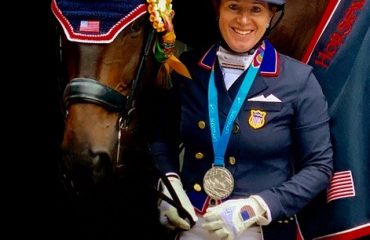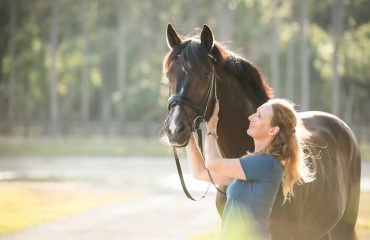
Brian Walker
Photo by Hervé Bonnaud, 1clicphoto.com
Brian Walker, a dual Canadian and American citizen, has trained, worked and ridden alongside the best in the world over the last 25 years. As a junior, Brian won the Maclay Medal Equitation Championship in 2001. Brian has made a name for himself by developing quality horses into successful competitors in both the hunter and jumper arenas, earning accolades for himself and his clients. Do you have a question you want Brian to answer? Send questions to editor@sidelinesnews.com.
I’m eager to improve and rise through the ranks of competition. Who would you suggest I watch in the grand prix to learn how to execute courses and ride better? Why are the people you suggest the best to watch?
Being a show jumper is about continuing to evolve and learning new things around every corner. Not only can good instruction help your riding move forward but simply watching different riders is also a great tactic to try to improve your own skills. There’s something to learn from every rider, some good and some bad. Learning what not to do is also a valuable aid in making yourself better. We often learn from our own mistakes, but if you can learn from others, you don’t make those mistakes to begin with. The best riders in the world are always good examples to follow. The way they warm their horses up or how they ride certain distances is valuable for everyone, but maybe a certain rider’s style better suits your style of riding, so I’d recommend following someone whose riding style is similar to yours. Classical riders are always a good bet. In the U.S., I’d recommend watching Kent Farrington, McLain Ward and Beezie Madden: Kent for his tactical ways and flawless execution; McLain for his discipline, control and precision; and Beezie for her strength and grit, which often goes unnoticed as she always seems so calm.
I find that when I’m competing, I keep raising my hands which, as you know, distracts my horse. Do you have any suggestions on how to combat this issue?
Position is always important to riding and it’s something I’m always practicing. Hands need to be steady throughout the course. Certain horses prefer some hand positions more than others; some work better with high hands and some work better with low hands. The key is that your hand position should always remain the same with even pressure on both reins. A lot of the time when we start moving our hands around, it can be distracting and we tend to start pulling on one rein or the other. Moving your hands around also will affect your body control. Good practice is carrying your hands in one position and only practicing that so all your effort goes into hand control. Carry them high and carry them low so you feel how each one works and then you can make corrections. It’s difficult to make corrections if you don’t know how the “wrong” way feels. One exercise I like for hand control is to carry a whip across the top of your hands where you hold it with your thumbs. It’ll make your hands work together.
If you had to ride in any other equestrian discipline, what would it be and why?
I’ve been jumping since I was a small child so it’s difficult to say what other discipline I’d enjoy. I used to play a lot of different sports including hockey. I still play some tennis and golf. Given that I’d say I have pretty good hand/eye coordination, I’d play polo. It requires some of the skills that I already have and to me, it’s like hockey on horseback. It has a fast pace, is exciting, played in good weather and you get to travel to a lot of cool places to play.
I compete in the Medal and Maclay regularly. I’m trying to get points towards indoors and I keep ending up in fifth place, right out of the points. It’s extremely frustrating. I know you had a lot of success in the equitation. What would you suggest I do to up my game and get into the top ribbons?
It’s sometimes a tedious task to get points required to qualify for indoors. Being out of points can be frustrating but you have to keep your head up and keep trying. Being fifth isn’t all bad — better than being last. You must take everything in perspective, analyze your round with your trainer on video and see what you can do to make it that much better in order to win. If you leave no question unanswered on course, then you’ll be in the top when you need to be. Sometimes you’ll find it’s your riding that needs work and other times you’ll find your horse needs better training. Often it’s a combination of both.
My trainer has started to record my sessions so that she can point out the areas I need to work on. I noticed that I don’t have proper body alignment. It almost looks like I have “chair seat,” a commonly used phrased for incorrect positioning because my legs slide forward. Do you have any recommendations on how to keep my body properly aligned?
Whenever we have problems, we must first correctly identify the problem in order to correct it. Sometimes that’s more difficult than fixing the problem itself. If a rider’s body is always behind the motion, then the rider’s legs will slide forward. One is a direct result of the other. In this case, it’s not the seat or body position that needs work, it’s the rider’s leg position that needs to be fixed. When your legs slide forward, the upper body will automatically slide back, or be behind the motion. The rider must work on strengthening their lower leg by riding more often (practice is always the cure). The rider can practice riding a few times per week without stirrups. Also, you should change the length of your stirrups to help get your leg into the correct position, which serves as a constant reminder of where your leg should be. This will allow the upper body to be in the right position. The rider should imagine their body as a straight line from the shoulder to the hips to the heels.













